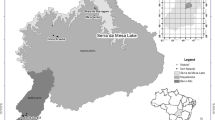Abstract
Species richness and composition of the Chrysomelidae (Coleoptera) were studied in larch (Larix kaempheri [Lamb.] Carrière) plantations, secondary forests, and primary forests. In addition, the effects of forest management practices, such as thinning and long rotation, were examined in the larch plantation. The species richness of Chrysomelidae was higher in the larch plantation than in the secondary forest or in the primary forest. Among the larch plantations, the species richness in old-aged plantations was higher than that in middle-aged plantations. The composition of the beetle assemblages in the larch plantation differed from that in the secondary forest or in the primary forest. Exosoma akkoae (Chujo), Batophila acutangula Heikertinger, and Calomicrus nobyi Chujo were caught with a bias toward the larch plantation. Longitarsus succineus (Foudras) and Sphaeroderma tarsatum Baly were caught more in the secondary forest and the primary forest, respectively. More B. acutangula and S. tarsatum were caught in stands where their host plants occurred at higher rates. Species richness of understory plants was an important factor for chrysomlid species richness, and frequency of host occurrence affected the number of individuals of leaf beetles examined. It seems that forest types and forest management practices affect host plants as well as Chrysomelidae, and that these effects on the host plants also influence chrysomelid assemblages.
Similar content being viewed by others
References
M. Dufrêne P. Legendre (1997) ArticleTitleSpecies assemblages and indicator species: the need for a flexible asymmetrical approach Ecol. Monogr. 67 345–366 Occurrence Handle10.2307/2963459
J. Fridman M. Walheim (2000) ArticleTitleAmountstructureand dynamics of dead wood on managed forestland in Sweden Forest Ecol. Manage. 131 23–36 Occurrence Handle10.1016/S0378-1127(99)00208-X
J.N. Greatorex-Davies T.H. Sparks (1994) ArticleTitleThe response of Heteroptera and Coleoptera species to shade and aspect in rides of coniferised lowland woods in Southern England Biol. Conserv. 67 255–273 Occurrence Handle10.1016/0006-3207(94)90617-3
P. Green G.F. Peterken (1997) ArticleTitleVariation in the amount of dead wood in the woodlands of the Lower Wye Valley, UK in relation to the intensity of management Forest Ecol. Manage. 98 229–238 Occurrence Handle10.1016/S0378-1127(97)00106-0
S. Kimoto H. Takizawa (1994) Leaf Beetles (Chrysomelidae) of Japan Tokai University Press Tokyo
K.J. Kirby C.M. Reid R.C. Thomas F.B. Goldsmith (1998) ArticleTitlePreliminary estimates of fallen dead wood and standing dead trees in managed and unmanaged forests in Britain J. Appl. Ecol. 35 148–155 Occurrence Handle10.1046/j.1365-2664.1998.00276.x
A.E. Magurran (1988) Ecological Diversity and its Measurement Princeton University Press Princeton, NJ
P. Martikainen J. Siitonen P. Punttila L. Kaila J. Rauh (2000) ArticleTitleSpecies richness of Coleoptera in mature managed and old-growth boreal forests in southern Finland Biol. Conserv. 94 199–209 Occurrence Handle10.1016/S0006-3207(99)00175-5
B. McCune M.J. Mefford (1999) PC-ORD. Multivariate Analysis of Ecological dataversion 4 MjM Software Design Gleneden Beach, Oregon
T. Nagaike (2002) ArticleTitleDifferences in plant species diversity between conifer (Larix kaempferi) plantations and broad-leaved (Quercus crispula) secondary forests in central Japan Forest Ecol. Manage. 168 111–123 Occurrence Handle10.1016/S0378-1127(01)00734-4
T. Nagaike A. Hayashi M. Abe N. Arai (2003) ArticleTitleDifferences in plant species diversity in Larix kaempferi plantations of different ages in central Japan Forest Ecol. Manage. 183 177–193 Occurrence Handle10.1016/S0378-1127(03)00105-1
M. Ohsawa (2004) ArticleTitleSpecies richness of Cerambycidae in larch plantations and natural broad-leaved forests of the central mountainous region of Japan Forest Ecol. Manage. 189 375–385 Occurrence Handle10.1016/j.foreco.2003.09.007
H. Qian K. Klinka B. Sivak (1997) ArticleTitleDiversity of the understory vascular vegetation in 40 year-old and old-growth forest stands on Vancouver IslandBritish Columbia J. Veg. Sci. 8 773–780 Occurrence Handle10.2307/3237021
H. ter Steege (1993) HEMIPHOTO, A Programme to Analyze Vegetation Indices, Light Quality from Hemispherical Photographs The Tropebos Foundation Wageningen
Author information
Authors and Affiliations
Corresponding author
Rights and permissions
About this article
Cite this article
Ohsawa, M., Nagaike, T. Influence of Forest Types and Effects of Forestry Activities on Species Richness and Composition of Chrysomelidae in the Central Mountainous Region of Japan. Biodivers Conserv 15, 1179–1191 (2006). https://doi.org/10.1007/s10531-004-4693-x
Received:
Accepted:
Issue Date:
DOI: https://doi.org/10.1007/s10531-004-4693-x




